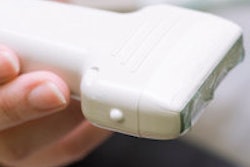
Compact or handheld ultrasound systems are now used across an array of specialties and clinical applications, often generating demand for ultrasound where none had existed. What's next? Possibilities abound, but a role as the stethoscope of the future isn't likely to be one of them.
Our work on tracking the ultrasound industry and working with scanner manufacturers in the past decade has provided a privileged, independent view of the reinvention of ultrasound technology. Initially seen by traditionalists as a fad, compact ultrasound has developed into a market of $1 billion in global annual sales in 2013. Strikingly, the vast majority of demand is derived from clinical applications that had little or no use for ultrasound technology 10 years ago.
Birth of POC ultrasound
The biggest change that allowed compact ultrasound to be so successful was a complete change in application. Traditionally, ultrasound was solely used by radiologists and obstetricians; image quality and advanced features were the most vital factors in any purchasing decision.
Point-of-care (POC) ultrasound imaging, championed by compact ultrasound suppliers such as SonoSite (now part of Fujifilm Medical Systems USA) and GE Healthcare, completely changed this mind-set in the early 2000s. Compact systems were sold to new users in areas such as anesthesiology and emergency medicine based on the merits of cost saving, efficiency, and improving patient outcomes.
While traditionalists scoffed at these "simplistic" systems and their novice users, they were unaware that the impending economic challenges and burdens of healthcare spending would soon change the landscape.
As evidence and support grew for compact system use, more competitors entered the market. System design changed and evolved, with new iterations such as the entry of palm-sized (GE's VScan) and "premium" laptop compact systems (e.g., Philips Healthcare's CX50).
Blurred conventions
Alas, the seeming clarity of POC and traditional ultrasound has blurred in more recent times. The surging demand from emerging markets such as Brazil, Russia, India, and China (BRIC) for low-cost ultrasound solutions, paired with the need of second- and third-generation POC users for more advanced tools and systems, is forcing manufacturers to offer a broader and less discrete product offering.
Cost, efficiency, and user workflow now dominate both traditional and POC markets. For many POC users, system mobility also has been realized to be less of a driving factor. Evidence of this can be seen in the vast majority of compact systems in today's market being sold with a cart; rarely do they leave the hospital or clinic they are used in.
To address the evolving needs of healthcare providers, small-footprint, cart-based systems have emerged. Offering more advanced features, larger displays, and more efficient workflow, these systems are quickly becoming viable alternatives to compact systems for many POC users.
Compact systems are also changing, adopting, and integrating consumer tablet and wireless technology, and penetrating into new markets such as interventional radiology and musculoskeletal imaging. Yet among all of these developments, the old adage still rings true for the vast majority of users: Size really does matter.
Purpose-defined form
With all new technology and design, the needs of users should be central to the design of the final product. This is even more critical in production of medical devices. Modern healthcare increasingly values systems that speed up or reduce cost, while also advancing clinical outcomes and improving ease of use.
 Stephen Holloway from IHS.
Stephen Holloway from IHS.
With this in mind, ultrasound has a strong opportunity compared with other imaging modalities. Its inherent characteristics of no radiation dose, flexibility, and relative low cost serve to position ultrasound as a leading imaging modality for the future.
However, to maximize this opportunity, ultrasound systems should be even more closely aligned to core user need. Too often, a single device or design of compact ultrasound is presented to the market as a one-size-fits-all solution for a vast spectrum of users. To be blunt, it is not, nor will it likely ever be.
Instead, user purpose will increasingly define the form and function of ultrasound systems. Small, mobile, tablet-based compact systems will undoubtedly increasingly emerge. Use of these systems should, however, be restricted to scenarios where mobility is essential and cellular connections can be utilized; rural doctors, paramedics, and sports medicine are three such examples.
For the majority of in-hospital POC users, "small-footprint" cart or "pedestal" workstation systems will increasingly emerge. Touch interfaces, IT connectivity, and automated presettings will be increasingly implemented. Users will also benefit from larger displays and improved image quality.
Interoperability between form factors also has some intriguing potential. An ultrasound tablet/PC hybrid, or tablet-docking station, should become more prevalent for use in emerging regions where the demand for mobility and broader functionality is required.
The ultrasound stethoscope?
You will have noted by now little mention of the "digital stethoscope" concept. The reasoning for this omission is simple: The concept has some significant flaws and will not play a major role in healthcare for many years to come unless major hurdles such as cost, training, and size and ergonomics are addressed.
Even basic low-end ultrasound systems have a significant average selling price, ranging from $5,000 to $10,000 for the most basic versions. Equipping every physician with an ultrasound stethoscope would be a costly exercise for any provider, particularly during stringent economic times. Reimbursement and tracking the performance of scans with stethoscope scanners also would cause major headaches for providers.
In addition, although many new ultrasound users have emerged with the advent of compact ultrasound, proper use and diagnosis with ultrasound is an art form that takes many years of experience and training. Producing a system that simplifies use and image capture will not help in the diagnostic process.
System size and ergonomics also remain an issue, as the display of any such stethoscope system would be just too small for anything but basic diagnosis. While current technology could be applied to improve resolution, such a system would be costly, ruling out a widespread rollout at a reasonable and affordable price point.
The ergonomics of such scanning also would be challenging. Ultrasound scanning requires dexterity and manipulation of the transducer, and this is a more difficult process if the scanner must be held by the user during the examination.
Therefore, while the future for compact ultrasound still looks relatively bright, the same rules of product design ring true and should be heeded.
Ultrasound systems must be developed and positioned specific to the user. As realization that mobility is rarely a necessity and demand for more complex features and processing increases in POC applications, uptake may slow for truly "mobile" systems. Instead, these systems will be replaced with a new generation of more efficient, powerful, user-friendly, small-footprint cart systems. In ultrasound, size really does matter.
Stephen Holloway is the associate director of medical devices and healthcare IT research at IHS. He can be reached at [email protected].
The comments and observations expressed herein do not necessarily reflect the opinions of AuntMinnie.com, nor should they be construed as an endorsement or admonishment of any particular vendor, analyst, industry consultant, or consulting group.



















